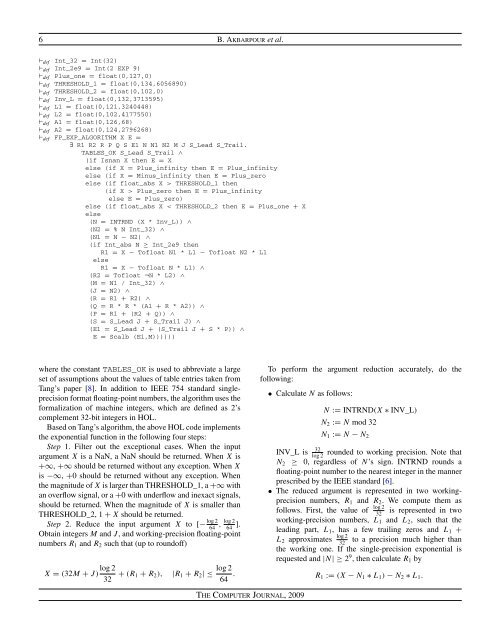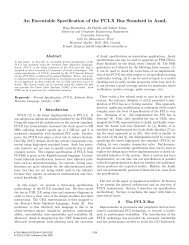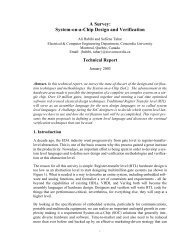Verifying a Synthesized Implementation of IEEE-754 Floating-Point ...
Verifying a Synthesized Implementation of IEEE-754 Floating-Point ...
Verifying a Synthesized Implementation of IEEE-754 Floating-Point ...
- No tags were found...
You also want an ePaper? Increase the reach of your titles
YUMPU automatically turns print PDFs into web optimized ePapers that Google loves.
6 B. Akbarpour et al.⊢ def Int_32 = Int(32)⊢ def Int_2e9 = Int(2 EXP 9)⊢ def Plus_one = float(0,127,0)⊢ def THRESHOLD_1 = float(0,134,6056890)⊢ def THRESHOLD_2 = float(0,102,0)⊢ def Inv_L = float(0,132,3713595)⊢ def L1 = float(0,121,3240448)⊢ def L2 = float(0,102,4177550)⊢ def A1 = float(0,126,68)⊢ def A2 = float(0,124,2796268)⊢ def FP_EXP_ALGORITHM X E =∃ R1 R2 R P Q S E1 N N1 N2 M J S_Lead S_Trail.TABLES_OK S_Lead S_Trail ∧(if Isnan X then E = Xelse (if X = Plus_infinity then E = Plus_infinityelse (if X = Minus_infinity then E = Plus_zeroelse (if float_abs X > THRESHOLD_1 then(if X > Plus_zero then E = Plus_infinityelse E = Plus_zero)else (if float_abs X < THRESHOLD_2 then E = Plus_one + Xelse(N = INTRND (X * Inv_L)) ∧(N2 = % N Int_32) ∧(N1 = N − N2) ∧(if Int_abs N ≥ Int_2e9 thenR1 = X − T<strong>of</strong>loat N1 * L1 − T<strong>of</strong>loat N2 * L1elseR1 = X − T<strong>of</strong>loat N * L1) ∧(R2 = T<strong>of</strong>loat ¬N * L2) ∧(M = N1 / Int_32) ∧(J = N2) ∧(R = R1 + R2) ∧(Q = R * R * (A1 + R * A2)) ∧(P = R1 + (R2 + Q)) ∧(S = S_Lead J + S_Trail J) ∧(E1 = S_Lead J + (S_Trail J + S * P)) ∧E = Scalb (E1,M))))))where the constant TABLES_OK is used to abbreviate a largeset <strong>of</strong> assumptions about the values <strong>of</strong> table entries taken fromTang’s paper [8]. In addition to <strong>IEEE</strong> <strong>754</strong> standard singleprecisionformat floating-point numbers, the algorithm uses theformalization <strong>of</strong> machine integers, which are defined as 2’scomplement 32-bit integers in HOL.Based on Tang’s algorithm, the above HOL code implementsthe exponential function in the following four steps:Step 1. Filter out the exceptional cases. When the inputargument X is a NaN, a NaN should be returned. When X is+∞, +∞ should be returned without any exception. When Xis −∞, +0 should be returned without any exception. Whenthe magnitude <strong>of</strong> X is larger than THRESHOLD_1, a +∞ withan overflow signal, or a +0 with underflow and inexact signals,should be returned. When the magnitude <strong>of</strong> X is smaller thanTHRESHOLD_2, 1 + X should be returned.Step 2. Reduce the input argument X to [− log 264 , log 264 ].Obtain integers M and J , and working-precision floating-pointnumbers R 1 and R 2 such that (up to round<strong>of</strong>f)X = (32M + J) log 232 + (R 1 + R 2 ), |R 1 + R 2 |≤ log 2To perform the argument reduction accurately, do thefollowing:• Calculate N as follows:N := INTRND(X ∗ INV_L)N 2 := N mod 32N 1 := N − N 232INV_L is rounded to working precision. Note thatlog 2N 2 ≥ 0, regardless <strong>of</strong> N’s sign. INTRND rounds afloating-point number to the nearest integer in the mannerprescribed by the <strong>IEEE</strong> standard [6].• The reduced argument is represented in two workingprecisionnumbers, R 1 and R 2 . We compute them asfollows. First, the value <strong>of</strong> log 2 is represented in two32working-precision numbers, L 1 and L 2 , such that theleading part, L 1 , has a few trailing zeros and L 1 +L 2 approximates log 232to a precision much higher thanthe working one. If the single-precision exponential isrequested and |N| ≥2 9 , then calculate R 1 by64 . R 1 := (X − N 1 ∗ L 1 ) − N 2 ∗ L 1 .The Computer Journal, 2009





